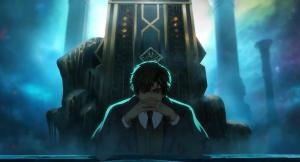Two weeks ago, DC released Generations: Forged #1 from writers Dan Jurgens, Robert Venditti, and Andy Schmidt and a murderer’s row of art talent hit the stands, and redefined the company’s timeline and multiverse, establishing something called the Linearverse, where heroes age slowly, giving the opportunity for evolution over time and a single Earth where everything happened and every version of every character lived at some point. The story centered on early iterations of some heroes — Booster Gold, Sinestro, Dr. Light, and other characters who are essentially their earliest versions. It’s both simple and complicated, but the biggest part of the story was that it was fun.
Videos by ComicBook.com
And, yes, it felt like it shared some DNA with Crisis on Infinite Earths, Zero Hour, 52, and other “Crisis-level” stories that have redefined the DC Universe. Even if, this time around, they seemed to do it in an intentionally low-key way.
The writing team behind Generations: Forged #1 joined ComicBook to break down the two-part story.
ComicBook: In some ways, this series feels like a sequel to Zero Hour. What was the balance of trying to “feel” like a DC Crisis without getting bogged down in continuity and things?
Dan Jurgens: I wouldn’t say it’s a sequel to Zero Hour, because we really tried to operate on a smaller scale and stay self-contained. We tried to stay with a very streamlined story that would have a sense of impact and leave the DCU with something to build on.
Robert Venditti: Zero Hour was a massive story — and masterfully executed by none other than Dan Jurgens — and I don’t think any of us wanted to compete with that. We wanted the stakes in Generations to be huge, and they are, but we also wanted to keep it close and personal. It’s rare that you get to write your own rules in a shared universe. More than anything, we leaned into that. If everything is on the table, which characters do we want to write and what impossible situations do we want to put them in. Steel and Superboy on pre-historic Thanagar? Let’s do it!
Andy Schmidt: Man, just hearing “sequel to Zero Hour” fills me with a sense of inadequacy! Ha ha! Zero Hour was huge and sweeping and changed everything — EVERYTHING. What we did was a little different, instead of ending up codifying everything and setting the status quo for a publishing line going forward, we wanted to celebrate the publishing lines going backward. The name Generations refers to the book in a lot of ways — yes, it’s a gathering of super-heroes who represent different generations in DC’s comics, but it also refers to different Generations of fans and different Generations of DC as a comics publisher. This is more a celebration of the Generations within DC itself and we hope that’s what our readers take away from it — the sense of joy we found in trying to tease all that out.
ComicBook: It’s rare to get a chance to write a story at DC where every universe and every timeline is available to mine if you’re so inclined. Was there a particular favorite place you got to visit in Generations?
Robert Venditti: I’d always wanted to write the Legion of Super-heroes, so it was great to be able to do that in Generations: Shattered, and reteam with Fernando Pasarin on art. But I have to say, my favorite scenes to write were the ones with Steel and Superboy in Generations: Forged. I’m such a huge fan of the Superman mythology, and I’d never had a chance to write either of those characters. And teaming up with Paul Pelletier again was a gift. The problem is, now I want to write those characters more…
Andy Schmidt: I’ve spent most of my career working on non-DC characters and in other media, so for me, these were all special to write. Steel really grew on me quite a bit during this process, as did Dr Light, but I have to say, just from a sheer gritty perspective, the first line of dialogue I wrote for Batman gave me pause. Batman was one of the few characters from childhood that I really hadn’t had the opportunity to work on, and writing Batman was just super cool.
Dan Jurgens: The 31st century is always a magical place, as is the world of OMAC. The environment that Jack Kirby built for OMAC seems especially prescient and relevant to today, what with city controlled by the super-rich. Plus, there are levels of governmental intrusion and monitoring that reflect the reality we now find ourselves in. There’s just so much to explore.
ComicBook: Some of the characters here are drawn from their most recognizable versions, but it could be argued that most people see Booster Gold now through the lens of Volume 2 and the time-travel adventures. Why reach back for the Vol. 1 version?
Dan Jurgens: We made a rather broad based decision to take these characters from their very earliest appearances across the board. That allowed us to use Sinestro when he was still a member of the Green Lantern Corps, for example. It meant Kamandi was younger and more inexperienced. It put Steel in his first and best looking armor. With Booster, the advantage was that he was no expert on time travel. He had a bit of knowledge and familiarity with it but had not yet become any kind of time cop.
ComicBook: A few years ago, I actually theorized that Lobdell was going to use Dominus in his Superman run — but what made him the ideal choice for this story?
Andy Schmidt: I remember talking about Dominus and moving on and then coming back to him. I wasn’t terribly familiar with the character having read his first appearances when they originally came out, but I didn’t have the clarity of what drove him. Once we started talking about our main cast and what was important to them as characters, we came back to Dominus and I remember when we hit on the importance of family and love for him, it clicked for me.
I don’t know that that was the defining moment for the others, but once I saw that relatable element and we hit on the 1950s era that he would create, all of these seemingly desperate elements of how time would work and shatter and why all just started easily coming together around Dominus’ core motivation and power set. It was very exciting to be a part of that.
Dan Jurgens: As a group, we were bouncing through different ideas of who our main adversary was going to be. I’m obviously quite familiar with Dominus, and floated him past editor Brian Cunningham and fellow writers Rob [Venditti] and Andy [Schmidt] at one point. We talked about it, put him aside and moved on to a couple of other ideas.
But the process of creation is never a straight line and the more we talked the more we realized that Dominus offered the level of power, scope and motivation that we needed so we went back to him and found a way to make it work.
Plus, since he hadn’t been seen in a while, he felt a bit fresh and somewhat flexible.
ComicBook: The idea that realities have always been there, just out of sight, rather than actually being destroyed, is a revelation to the characters here — but is that how you view the worlds that are destroyed in each subsequent Crisis event? Certainly it’s how The CW explicitly dealt with their post-Crisis multiverse.
Dan Jurgens: I hadn’t thought about it that way, but I certainly see your point!
For me, on a personal level, I find it harder to accept the notion of entire planes of reality being destroyed, only to be recreated again. “Hiding” them or making them inaccessible actually seems much more believable. The amount of energy required to destroy and recreate universes is tremendous, after all.
Plus, we weren’t going to change anything. The Linearverse was meant to stay much the way it had been, which is a place that is belt around DC’s published history.
Robert Venditti: To steal from Dan a bit, I hadn’t really thought of that. I don’t know if it’s important to me that definitive explanations are made. Mostly, I want to leave toys in the sandbox for other creative teams to play with. I think we’ve done that.
Andy Schmidt: One of the things that I generally want to shy away from as a creator is writing over someone else’s work or saying that it never happened. Because it happened for the reader and for the creators who put those stories together. They’re real and they’re important to someone.
Most of the comics I grew up reading that got me into comics in the first place have been retconned so they never happened, but they’re still what made me fans of those characters in the first place. So, for me, it’s just kind of a respect thing for fans and creators both. If it’s real to you — I should treat it as such. Generations Shattered and Forged gave us a platform to re-validate those “hidden” stories as you called them. To let readers and creators know we remember, and we still love those stories, while also crafting something new to introduce those takes on characters to new fans. It’s challenging and it’s fun and I think it’s upbeat in the approach and hopefully in its execution.









